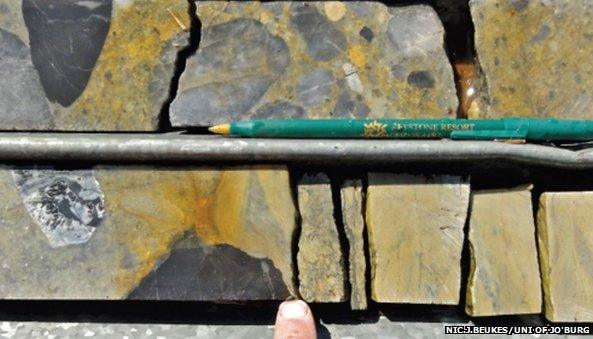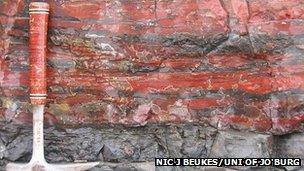Ancient soils provide early whiff of oxygen
- Published

The ancient soils are now compacted back into rock. They show a slight depletion in chromium-53
Oxygen may have been accumulating in Earth's atmosphere hundreds of millions of years earlier than we thought.
An international team has made the claim in Nature magazine, external after studying the oldest soils on Earth.
The researchers say elements in the three-billion-year-old material show evidence for oxidative weathering.
This is some 700 million years before the Great Oxidation Event when other geological data points to a dramatic rise in free O2 in the atmosphere.
If confirmed, it is a significant observation because it suggests the ability of ancient lifeforms to produce oxygen may also have got going earlier than previously recognised.
"Oxygenic photosynthesis is a very complicated metabolism and it makes sense that the evolution of such a metabolism would take perhaps two billion years - that we might not see its manifestation until the Great Oxidation Event. But now that we see oxygen much earlier in the atmosphere, it tells us that even really complex metabolisms can evolve very fast," said team-member Dr Sean Crowe from the University of British Columbia, Canada.
The group looked at remnant soils, dated to about 2.95 billion years ago, which have subsequently become locked up in rocks in what is now Kwazulu-Natal Province, South Africa.
In particular, the researchers studied the ratios of different types, or isotopes, of chromium atoms that were present in the palaeosoils.
Subtle chemistry
These isotopes are very sensitive to reactions involving oxygen, with the heavier form of the atom, chromium-53, becoming slightly more soluble when oxidised than the lighter chromium-52 type.

Marine sediments in Kwazulu-Natal show a very slight enrichment in chromium 53
It means that, over time, soils that have been oxidised should become depleted in chromium-53 as rain water washes away these atoms; and, conversely, sea sediments, where the products of weathering eventually end up, should become enriched in chromium-53.
The team made precisely this observation in Kwazulu-Natal, in rocks that represented both ends of the process - the soils and the sea sediments.
The conclusion is that the ancient soils would have been exposed to an atmosphere that contained 0.03% of the oxygen it does now; about one-10,000th of the present level.
"This is considerably more than people had estimated," said team-member Prof Michael Bau, from Jacobs University, Bremen, Germany.
"There is some evidence also for a whiff of oxygen at around 2.6-2.7 billion years ago based on molybdenum isotope systems. But the important point about these older whiffs is that they probably represent episodic increases, and it is not until 2.3-2.4 billion years ago that we see an irreversible oxygenation of the atmosphere," he told BBC News.
This was the Great Oxidation Event, which coincided with a big rearrangement of the Earth's continents, creating vast shallow-water shelf environments where photosynthetic cyanobacteria could really flourish.
Protective layer
It was a very significant moment in the story of Earth because some of the abundant oxygen would then have been converted in the atmosphere into ozone.
This three-atom oxygen molecule filters damaging ultraviolet light from the Sun, and would have enabled many new classes of life to emerge.
The team, which includes co-workers at the universities of Copenhagen and Johannesburg, wishes to test its findings further on rocks from other parts of the world.
This is not straight-forward, however, as three-billion-year-old rocks are extremely rare - certainly, those that have also not undergone significant alteration. But the scientists hope to find suitable material to work on in Greenland and Australia.
"One of the key aspects of all this is the sensitivity now of techniques such as the chromium isotopes, which allow us to probe very low levels of oxygen. And I'm sure continued technological advances will eventually enable us to look for even lower levels of oxygen, even earlier in time," said Dr Crowe.
Jonathan.Amos-INTERNET@bbc.co.uk and follow me on Twitter: @BBCAmos, external
- Published4 December 2012
- Published10 November 2010